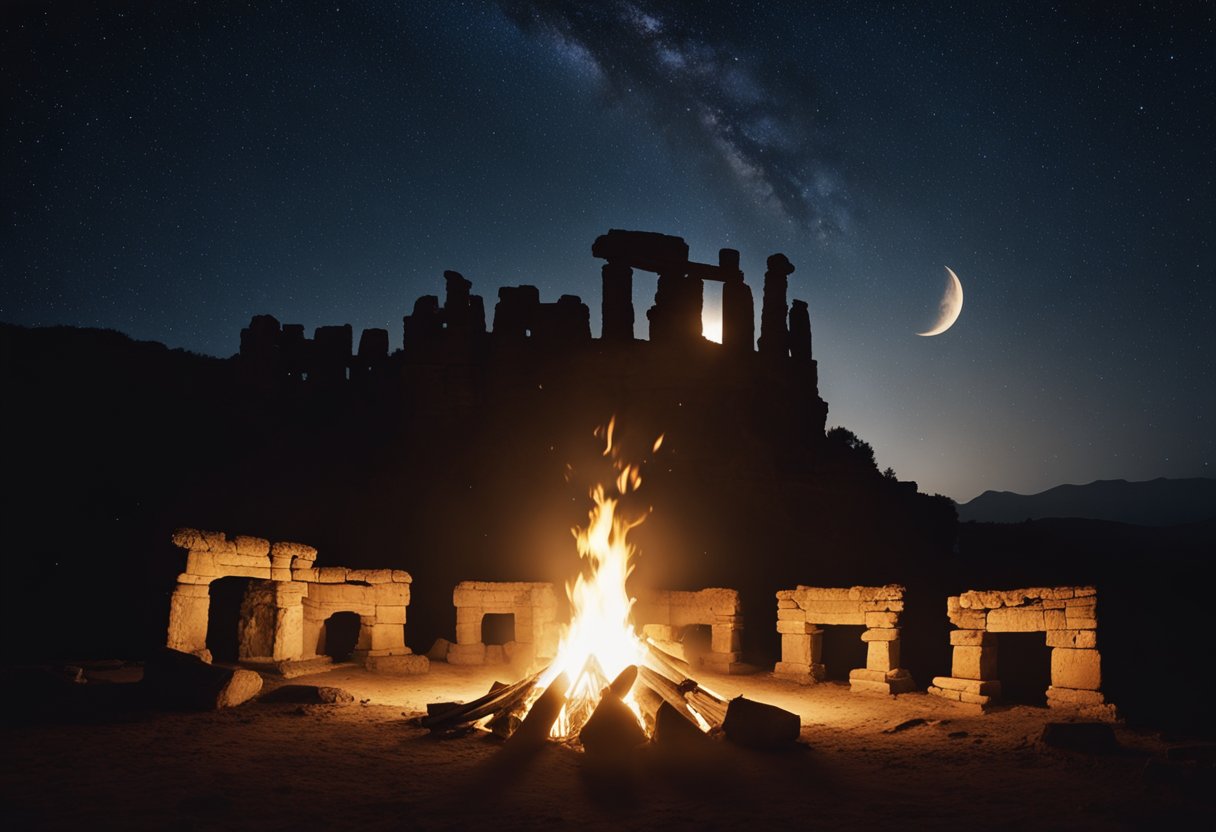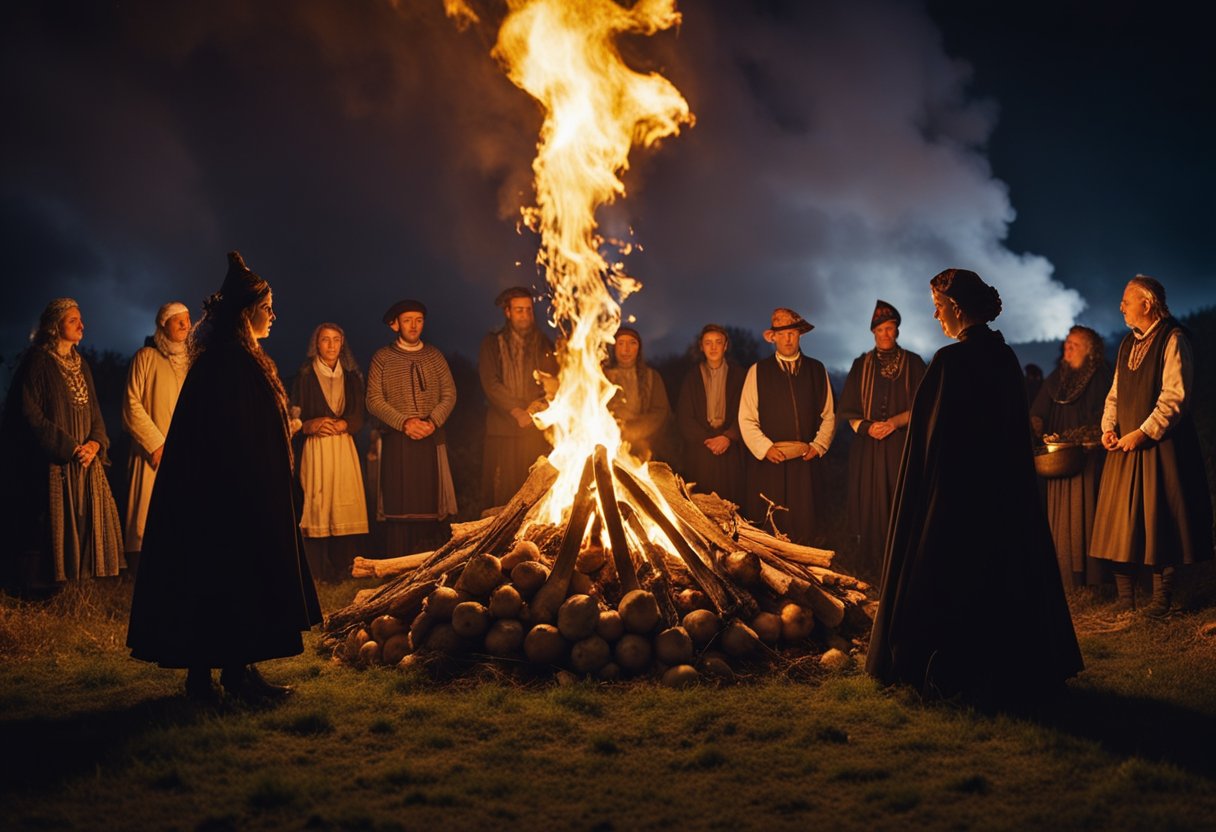Oíche Shamhna: Tracing Halloween’s Roots in Celtic Tradition

Updated On: April 20, 2024 by Eman Sameh
Oíche Shamhna, or the evening of Samhain, marks what is considered by many to be the origin of the modern Halloween. In ancient Ireland, Samhain signalled the end of the harvest season and the onset of winter. This time of year was of profound importance, embodying both practical agricultural significance and deep spiritual belief. The ancient Celts believed that the barrier between our world and the otherworld thinned during Samhain, allowing spirits to pass through. The festival, rich in traditions and lore, was a time for feasting, divination, and honouring the dead.

Adapting over the centuries, these ancient practices were influenced by the spread of Christianity, which brought with it new festivities such as All Hallows’ Eve, eventually melding with indigenous traditions to form Halloween. Ireland, with its strong cultural ties to the past, continues to embrace Oíche Shamhna with both traditional and contemporary practices, allowing us to trace the evolution of this holiday from its Celtic roots through to present-day celebrations.
The Historical Roots of Halloween
Halloween’s origins are deeply rooted in the ancient Celtic festival of Samhain. This festival marked the end of the harvest and the ushering in of the new year, intertwining pagan practices with later Christian influences.
Samhain: The Celtic New Year
Samhain was celebrated by the Ancient Celts, particularly in Ireland, as the mark of the Celtic New Year. It was believed to be a time when the boundary between the living and the dead became blurred. The Celts used this time to connect with the spirit world, often invoking protection rituals and divination for the coming year. Celebrated across Celtic Culture, Samhain festivities were a significant influence on today’s Halloween traditions.
From Pagan Rituals to Christian Celebrations
As Christianity spread throughout Celtic lands, pagan holidays such as Samhain began to merge with Christian observances. November 1st was designated as All Saints’ Day, a time to honour all saints and martyrs. This assimilation of traditions led to the development of All Hallows’ Eve, the night before All Saints, where some of the old Celtic practices remained, albeit with a new Christian veneer.
Archaeological Insights
In County Meath within the Boyne Valley, archaeological findings, such as the Passage Tombs at Newgrange and Knowth, offer valuable insights into the celebration of Samhain. These sites illustrate that even in prehistoric times, there was a significant emphasis on the cyclical nature of seasons. Their alignment with the sun’s movements suggests the ancients’ sophisticated understanding of astronomy and its integration into their spiritual and agricultural lives.
In exploring the roots of Halloween, we celebrate not just a night of fun and fright but also a rich historical tapestry woven from the lives and beliefs of the Ancient Celts.
Oíche Shamhna Traditions and Celtic Lore
Oíche Shamhna, more widely known as Halloween, has raw and mystical roots deeply embedded in Celtic tradition. It is specifically tied to festival times such as Samhain, when the veil between the natural and the supernatural was believed to be thin.
Bonfires and the Hill of Tara
One cannot think of Oíche Shamhna without conjuring images of bonfires igniting the night sky. These fires were central to Samhain celebrations, signifying a cleansing and protective ritual. At the Hill of Tara, once the seat of the High Kings of Ireland, these bonfires held significant status, serving as beacons inviting friendly spirits and ancestors while warding off any malevolent entities from the Otherworld. It was on hills like Tara and Tlachtga (now the Hill of Ward) that the Druids observed this liminal time, with flames lighting the darkness, symbolising the perpetual cycle of life and death.
Divination Practices and Beliefs
Divination, or the pursuit to foresee or foretell future events, was an integral part of Oíche Shamhna. Objects like stones and nuts were employed in various rituals to divine information about life’s key aspects—marriage, health, and prosperity. These divination practices were not mere superstitions but a profound expression of Celtic mythology, believed to offer guidance directly from the ancestors and otherworldly spirits at a time when the boundary between this world and the next was at its thinnest.
Folklore and the Supernatural
The rich folklore of Oíche Shamhna is populated with beings from the benign to the fearsome. Fairies and spirits roamed free, and it was well advised to honour them to avoid misfortune. Stories of the banshee, with her mournful wails signalling an impending death, embody the deep connection with the ancestors and the ever-presence of the Otherworld. This folklore has been preserved and passed down through generations since the Middle Ages, reflecting a time when nature’s cycles and supernatural forces were intrinsic to daily life and belief systems in Celtic societies.
Seasonal Changes and Agricultural Significance
As we explore the Celtic festival of Oíche Shamhna, it’s crucial to understand its connection to the seasonal transitions and the agricultural calendar. This period signified the end of the harvest and the onset of winter, marking it not just as a time of celebration but also of survival.
Harvest’s End and Winter’s Beginning
The celebration of Oíche Shamhna coincides with the end of the harvest, a pivotal time in the Celtic year. It is a time to gather the final crops and prepare for the colder months ahead. Our ancestors recognised this period as a mark of transition from the light, bountiful months of summer to the cold, dark days of winter. This seasonal shift was not merely symbolic but had significant implications for agricultural practices and food security.
Cattle, Crops, and Hearth Fires
As the harvest concluded, attention turned to cattle, which were central to Celtic agriculture. They provided milk, which was an essential part of the diet, and with the coming of winter, some cattle were chosen for slaughter to provide meat through the colder months. This was also a time to reinforce the home against the impending winter; hearth fires were of crucial importance. They served as a source of warmth, a cooking site, and a focal point for communal gatherings within the home. It was critical to ensure that the fires remained lit, as they signified the warmth and light that would see our communities through the dark season.
The practices around Oíche Shamhna were intertwined with the rhythms of the natural world and underscored the reliance on and respect for the cycles of growth and dormancy that governed rural life.
Festivities and Customs of Ancient Celts
The ancient Celts celebrated Oíche Shamhna with vibrant customs and communal practices that lay at the heart of their autumnal festivities.
Costumes and Disguises
In our Celtic tradition, costumes played a crucial role during the festival of Samhain. We, the ancient Celts, would don elaborate disguises as a means to ward off harmful spirits. Costumes often comprised animal skins and heads, reflecting our closeness with nature and belief in its protective powers. Menacing guises served a dual purpose; alongside protection, they allowed us to connect with the dead, embodying the very essence of the Festival of the Dead.
Feasts and Communal Gatherings
Feasts were at the core of our Samhain celebrations, culminating in grand communal gatherings. As ancient Celts, we united our communities by sharing bountiful harvests. A key custom was the communal bonfire, which was symbolic of our interconnectedness and a ritual for cleansing and protecting. Around these fires, we shared tales and food, honouring our ancestors and the significant Celtic traditions that shaped our seasons and society.
Christianity’s Influence on Halloween

Before delving into the specific transformations of Halloween through Christian tradition, it’s important to acknowledge that the festival has shifted from its pagan origins to a celebration influenced heavily by Christian practices.
All Hallows’ Eve Transformation
In the eighth century, Pope Gregory III designated November 1 as a time to honour all saints and martyrs; this holiday became known as All Saints’ Day. This also marked a turning point for the Celtic festival of Samhain, which coincided with this time of year. It’s believed that Pope Boniface IV initially introduced the concept of All Hallows’ Eve, the evening before All Saints’ Day, to incorporate and Christianise the existing pagan festival. By the ninth century, the influence of Christianity had expanded into Celtic lands, where blending these celebrations together became more commonplace.
All Saints’ and All Souls’ Day Integration
All Saints’ Day was followed by All Souls’ Day on November 2, which was a day set aside for praying for the deceased. This was a time for the living to assist those in purgatory through prayers, and it was common to light candles for the dead, a tradition reminiscent of Samhain’s fire rituals. The two days collectively reinforced the idea of continuity from this life to the next while also integrating Christian teachings about heaven, hell, and salvation. This period, spanning over three days, popularly known as Allhallowtide, provided a time for piety and remembrance within the Christian community and influenced Halloween’s evolution from a secular to a religious observance.
Symbolism and Iconography
In our examination of Oíche Shamhna, we uncover the intricate symbolism and iconography that trace back to its Celtic origins. These elements are not merely festive decorations but carry profound meanings tied to ancient rituals and beliefs.
Pumpkins and Turnips
Pumpkins, now synonymous with Halloween, were not originally part of the Celtic festival. Traditionally, it was the turnip that was carved into lanterns as a way to ward off evil spirits. The pumpkin only became a Halloween symbol after Irish immigrants in America discovered that pumpkins were more abundant and easier to carve than turnips. These carvings represent the light that guides lost souls and keeps at bay darker entities, a practice rooted in the ancient celebration of the dwindling sun and the encroaching dark of winter.
The Witches and Otherworld Entities
Witches hold a strong presence in Halloween’s iconography, often depicted as figures with the power to traverse the thinning veil between our world and the Otherworld. This connection is tied to the belief that during Samhain, the boundaries separating the living from the dead and humans from supernatural beings were especially permeable. The portrayal of witches during Halloween echoes these powerful female entities’ Celtic reverence and fear.
Entities such as the Devil and representations of Death are common during Halloween. These figures are emblematic of the darker aspect of the festival, which contemplates the cycle of life and death and the existence of malevolent forces. These figures remind us of our close proximity to the spirit realm during this liminal time.
Costumes were worn during the original festivities not just as a means of celebrating but as a way to disguise oneself from malevolent spirits wandering the earth. Through costume-wearing, individuals could avoid being recognised by these spirits, a tradition that underscores the festival’s deep-seated roots in the concept of an intersection with the Otherworld and a deep respect for the forces that govern life and death.
The Evolution of Modern Halloween Practices
As we examine the transition from ancient rituals to today’s Halloween festivities, it’s evident that core elements like dressing up and the use of pumpkins are deeply entrenched in Celtic traditions. Our exploration reveals the profound transformation of Halloween, which has adapted across time and cultures.
Trick-or-Treating and Games
Trick-or-treating evolved from the ancient Celtic practice of leaving treats out to pacify spirits during Samhain. In the 19th century, people began dressing up in costumes and performing for treats—a habit that has since morphed into the trick-or-treating we recognise today. Games, particularly those involving apples, such as bobbing for apples, have their origins in Roman festivals but have been integrated into Halloween over centuries, symbolising fortune-telling and love predictions in Celtic customs.
Global Adaptation and Pop Culture
Our Halloween customs have stretched beyond their Celtic roots to embrace global influences. The celebration has been adapted worldwide, with unique practices springing up in various cultures, reflecting local traditions and historical events. Pop culture, especially films and media, plays a significant role in shaping the modern Halloween aesthetic and activities, spreading the excitement of Halloween and its associated practices across borders.
Halloween in the Gaelic and Celtic Regions
We observe that Halloween, known as Oíche Shamhna in Ireland, has deep roots in the Gaelic and Celtic traditions. The celebration retains many of its original forms in the Gaelic-speaking regions such as Ireland, Scotland, and Wales, each adding its own cultural nuances.
Celebration Differences in Ireland, Scotland, and Wales
In Ireland, Oíche Shamhna still holds significant cultural importance. Traditionally, it marks the end of the harvest season and the onset of winter. Today, many Irish people celebrate with events that reflect the Gaelic festival’s ancient traditions, like bonfires and costumes to ward off spirits. On the other hand, Scotland observes similar practices with somewhat distinct customs. The Scottish celebrate Halloween with guising—the practice of dressing up in costumes—reminiscent of the old Celtic tradition of disguising oneself to evade harmful spirits. Wales celebrates Calan Gaeaf with traditional festivities that include the sharing of tales and embracing of the winter season ahead.
The Revival of Samhain Festivals
Samhain festivals, once central to Celtic tradition, are experiencing a revival across these regions. In many communities, the ancient Celtic traditions connected to Samhain are being brought to life through modern celebrations. Public gatherings and festivals now feature ancient customs, such as the lighting of sacred fires and offerings to the aos sí—the spirits or fairies thought to be particularly active during Samhain. In bringing back these practices, the Celtic regions are not only preserving their history but are fostering a renewed interest in the significance of their ancestral rituals.
Legends and Mythological Figures
Exploring the Celtic origins of Oíche Shamhna, or Halloween, is intriguing. One can delve into the mythological tapestry that includes legendary figures and ferocious monsters integral to ancient Irish lore.
The High Kings of Ireland and Mythological Heroes
Ancient Ireland was a land steeped in tales of High Kings and mythical champions whose deeds have echoed through time. One such hero, Fionn Mac Cumhaill, renowned as a warrior and leader of the Fianna, stands out. He features prominently in the tale of the Salmon of Knowledge, which bestowed upon him all the world’s knowledge with a single taste. It was during the Iron Age that such heroes, possibly inspired by real figures, captured the imagination, their stories often interwoven with the Druid priests who held significant power and influence.
Monsters and Guardians in Celtic Lore
Our ancestors whispered of terrifying creatures such as the Fomorians (Fomor), a malevolent race of monstrous beings that represented chaos and wild nature, often clashing with the early settlers of Ireland. The concept of mumming, dressing in disguise, which is a precursor to modern-day trick-or-treat traditions, may have roots in adopting the guise of these entities during Samhain to ward off evil spirits or appease them. The lore is a complex web that offers insight into the fears and beliefs of the time, showcasing a world where every mountain and river might harbour a guardian spirit or a fearsome beast.
Liminality and the Thin Veil Concept
In exploring Oíche Shamhna, we recognise a key theme: the concept of liminality—where the ordinary limits of time and space appear to blur. This moment is profoundly symbolised by the thin veil, representing a permeable boundary between our world and the Otherworld.
The Meeting of the Worlds
The ancient Celtic festival of Samhain, which we now celebrate as Halloween, is deeply rooted in the notion of liminality or a liminal time when the distinction between our world and the Otherworld is at its most fragile. It’s a seasonal juncture where the Celts believed the veil between the living and the dead grew so thin that the spirits could pass through. During Samhain, it was thought that our ancestors could revisit the mortal realm, and so the living would honour the dead, acknowledging their presence among us. This concept forms a vital part of Celtic folklore and mythology, continuing to captivate the imagination in modern celebrations.
Samhain Night and the Supernatural
The night of Samhain is steeped in the supernatural. It’s a period marked by a heightened presence of spirits, entities from Celtic mythology, and the dearly departed—ancestors whose memories are evoked and celebrated. Tales of the púca, a shape-shifting creature from Irish folklore, abound, encapsulating the essence of Samhain’s mystical tradition. Folklore from this time speaks of a world alive with otherworldly activity, offering a thrilling connection to the enigmatic realm of the supernatural.
Frequently Asked Questions
In this section, we cover some of the most common inquiries regarding the ancient festival of Oíche Shamhna and its transformation into the Halloween we know today.
What are the Celtic origins of Halloween?
Halloween’s origins are deeply rooted in the ancient Celtic festival known as Samhain. Celebrated from October 31 to November 1, it marked the end of the harvest season and the onset of the darker half of the year.
How is Oíche Shamhna celebrated in Irish tradition?
Traditionally, Oíche Shamhna is a time for remembering ancestors and involves several practices, such as lighting bonfires and enjoying festivities that include music, dance, and storytelling to honour the past.
What does the term ‘Samhain’ signify in the context of Halloween’s history?
The term ‘Samhain’, which is pronounced “sow-win”, indicates the end of the harvest and the beginning of winter in Gaelic. It is associated with a time when the veil between the living and the spirit world is thinnest.
How has the festival of Samhain evolved into modern Halloween celebrations?
Over time, Samhain has evolved, blending with other cultural traditions, notably those of Christian All Saints and All Souls’ Days. This evolution has led to the modern Halloween traditions of trick-or-treating and costume-wearing.
What is the significance of October 31st in relation to Oíche Shamhna?
October 31st signifies the eve of Samhain, the beginning of the Celtic New Year. It was believed that on this night, the boundary between our world and the otherworld could be more easily crossed.
Can you explain the connection between ancient Celtic festivals and contemporary Halloween customs?
Ancient Celtic festivals like Samhain have directly influenced contemporary Halloween customs. For example, the tradition of carving turnips or pumpkins stems from the practice of creating lanterns to ward off spirits during Samhain.






